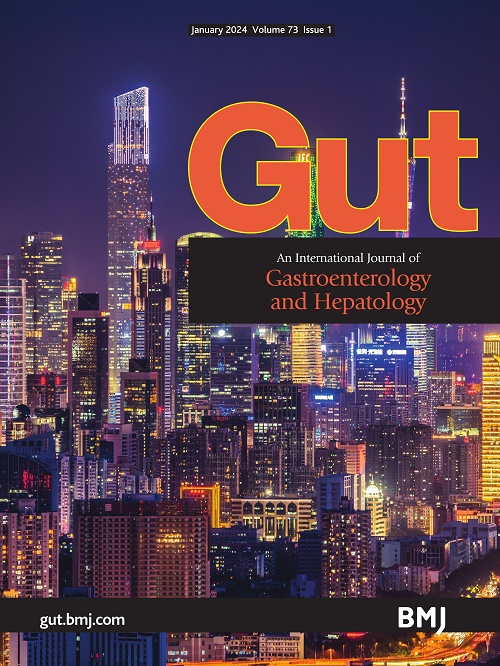突变型 GNAS 的代谢重编程在胰腺导管内乳头状粘液瘤中产生了可操作的依赖性
IF 23
1区 医学
Q1 GASTROENTEROLOGY & HEPATOLOGY
引用次数: 0
摘要
背景 KRAS 和 GNAS 的致癌 "热点 "突变是导管内乳头状黏液性肿瘤(IPMNs)的两个主要驱动基因改变,而 IPMNs 是胰腺导管腺癌的真正前体。我们以前曾报道过,在 p48Cre; KrasLSL-G12D; Rosa26LSL-rtTA; Tg (TetO-GnasR201C) 小鼠("Kras;Gnas "小鼠)中,胰腺特异性 Kras G12D 和 Gnas R201C 的共同表达会导致再现 IPMNs 的囊性病变的发生。目的 我们旨在揭示突变 Gnas R201C 表达对表型、转录组特征和基因组依赖性的影响。设计 我们在'Kras;Gnas'自体模型和肿瘤衍生细胞系(Kras;Gnas 细胞)中进行了多模式转录谱分析(大容量 RNA 测序、单细胞 RNA 测序和空间转录组学),其中 Gnas R201C 的表达是可诱导的。研究人员进行了全基因组 CRISPR/ Cas 9 筛选,以确定 KrasG12D;GnasR201C 共表达细胞中的潜在漏洞。结果 Gnas R201C 的诱导以及由此产生的 G(s)alpha 信号导致胰腺肿瘤上皮细胞出现胃(幽门型)化生的基因特征。CRISPR 筛选确定了糖酵解相关基因 Gpi1 和 Slc2a1 在 Kras G12D; Gnas R201C 共表达细胞中的合成必要性。在 Kras;Gnas 细胞和自体 Kras;Gnas 模型中进行的实时代谢分析证实了 Gnas R201C 诱导的糖酵解增强。诱导 Gnas R201C 使 Kras G12D 表达细胞的存活更依赖于糖酵解。蛋白激酶 A 依赖性糖酵解中间酶 6-磷酸果糖-2-激酶/果糖-2,6-二磷酸酶 3(PFKFB3)的磷酸化是 Gnas R201C 诱导糖酵解增强的驱动因素。结论 多种正交方法证明,在 IPMN 发病过程中,Kras G12D 和 Gnas R201C 的共同表达会导致胃幽门化和糖酵解依赖性的基因特征。观察到的代谢重编程可能为治疗和阻断 IPMNs 提供了潜在靶点。数据可在公开、开放的资源库中获取。本研究中产生的大量RNA-seq、单细胞RNA-seq和空间转录组数据集已存入NCBI基因表达总库(GEO)数据库,登录号为GSE275406。本文章由计算机程序翻译,如有差异,请以英文原文为准。
Metabolic reprogramming by mutant GNAS creates an actionable dependency in intraductal papillary mucinous neoplasms of the pancreas
Background Oncogenic ‘hotspot’ mutations of KRAS and GNAS are two major driver alterations in intraductal papillary mucinous neoplasms (IPMNs), which are bona fide precursors to pancreatic ductal adenocarcinoma. We previously reported that pancreas-specific Kras G12D and Gnas R201C co-expression in p48Cre; KrasLSL-G12D; Rosa26LSL-rtTA; Tg (TetO-GnasR201C) mice ( ‘Kras;Gnas ’ mice) caused development of cystic lesions recapitulating IPMNs. Objective We aim to unveil the consequences of mutant Gnas R201C expression on phenotype, transcriptomic profile and genomic dependencies. Design We performed multimodal transcriptional profiling (bulk RNA sequencing, single-cell RNA sequencing and spatial transcriptomics) in the ‘Kras;Gnas ’ autochthonous model and tumour-derived cell lines ( Kras;Gnas cells), where Gnas R201C expression is inducible. A genome-wide CRISPR/ Cas 9 screen was conducted to identify potential vulnerabilities in KrasG12D;GnasR201C co-expressing cells. Results Induction of Gnas R201C—and resulting G(s)alpha signalling—leads to the emergence of a gene signature of gastric (pyloric type) metaplasia in pancreatic neoplastic epithelial cells. CRISPR screening identified the synthetic essentiality of glycolysis-related genes Gpi1 and Slc2a1 in Kras G12D; Gnas R201C co-expressing cells. Real-time metabolic analyses in Kras;Gnas cells and autochthonous Kras;Gnas model confirmed enhanced glycolysis on Gnas R201C induction. Induction of Gnas R201C made Kras G12D expressing cells more dependent on glycolysis for their survival. Protein kinase A-dependent phosphorylation of the glycolytic intermediate enzyme 6-phosphofructo-2-kinase/fructose-2,6-biphosphatase 3 (PFKFB3) was a driver of increased glycolysis on Gnas R201C induction. Conclusion Multiple orthogonal approaches demonstrate that Kras G12D and Gnas R201C co-expression results in a gene signature of gastric pyloric metaplasia and glycolytic dependency during IPMN pathogenesis. The observed metabolic reprogramming may provide a potential target for therapeutics and interception of IPMNs. Data are available in a public, open access repository. Bulk RNA-seq, single-cell RNA-seq and spatial transcriptomic datasets generated in this study have been deposited in the NCBI Gene Expression Omnibus (GEO) database under accession number GSE275406.
求助全文
通过发布文献求助,成功后即可免费获取论文全文。
去求助
来源期刊

Gut
医学-胃肠肝病学
CiteScore
45.70
自引率
2.40%
发文量
284
审稿时长
1.5 months
期刊介绍:
Gut is a renowned international journal specializing in gastroenterology and hepatology, known for its high-quality clinical research covering the alimentary tract, liver, biliary tree, and pancreas. It offers authoritative and current coverage across all aspects of gastroenterology and hepatology, featuring articles on emerging disease mechanisms and innovative diagnostic and therapeutic approaches authored by leading experts.
As the flagship journal of BMJ's gastroenterology portfolio, Gut is accompanied by two companion journals: Frontline Gastroenterology, focusing on education and practice-oriented papers, and BMJ Open Gastroenterology for open access original research.
 求助内容:
求助内容: 应助结果提醒方式:
应助结果提醒方式:


